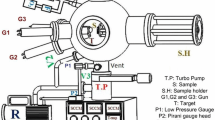Abstract
Polyethylene terephthalate (PET) has been modified by Si ion implantation with a dose ranging from 1×1016 to 2×1017 ions/cm2 using a metal vapor vacuum arc (MEVVA) source. The surface morphology was observed by atomic force microscopy (AFM). The change in the microstructure of Si implanted PET was observed with a transmission electron microscope (TEM). It is believed that the change would improve the conductive properties and wear resistance. The electrical properties of PET have been improved via Si ion implantation. The resistivity of implanted PET decreased obviously with an increase in ion dose. When Si ion dose was 2×1017 cm−2, the resistivity of PET could be less than 7.9 Ω·m. The surface hardness and modulus increased obviously. The mechanical property of the implanted PET has been modified greatly. The hardness and modulus of Si implanted PET with a dose of 2×1017/cm2 are 12.5 and 2.45 times greater than those of pristine PET, respectively. The area of cutting groove for Si implanted PET is narrower and shallower than those of the unimplanted PET. So the wear resistance is greatly raised. In comparison with metal ion implantation, the improvement of mechanical properties is obvious in ion implantation into PET. Si ion beam modification mechanism of PET is discussed.
Similar content being viewed by others
References
Lee, E. H., Rao, G. R., Lewis, M. B. et al., Ion implantation application for improved polymer surface properties, Nucl. Instr. Meth., 1993, B74:326–330.
Wang, Y. Q., Mohite, S. S., Bridwell, L. B., Modification of high temperature and high performance polymer by ion implantation, J. Mater. Res., 1993, 8(2): 388–401.
Popok, V. N., Karpovich, I. A., Odzhaev, V. B. et al., Structure evolution of implanted polymer: Buried conductive layer formation, Nucl. Instr. Meth., 1999, B148, 1106–1110.
Lee, E. H., Ion beam modification of polymeric materials-fundamental principles, Nucl. Instr. Meth., 1999, B151: 29–41.
Sofield, C. J., Sugden, S., Ing, J. et al., Ion beam modification of polymer, Vacuum, 1993, 44(3/4): 285–290.
Cottin, P., Lessard, R. A., Knystautas, E. J. et al., Polymer waveguides under ion implantation: Optical and chemical aspects, Nucl. Instr. Meth., 1999, B 15: 97–100.
Zhang Tonghe, Wu Yuguang, Science and Application of Ion Beam Modification of Materials (in Chinese), Bei**g: Science Press, 1999, 529.
Rao, G. R., Monar, K., Lee, E. H. et al., Metal ion implantation effects on polymer modified by metal ion implantation, Surface and Coatings technology, 1994, 64: 69–74.
Wu Yuguang, Zhang Tonghe, Huixing Zhang. et al., Electrical properties of polymer modified by metal ion implantation, Nucl. Instr. Meth., 2000, B 169: 89–93.
Author information
Authors and Affiliations
Corresponding author
Rights and permissions
About this article
Cite this article
Wu, Y., Zhang, T., Liu, A. et al. The modification behaviour for Si implanted PET. Sci. China Ser. E-Technol. Sci. 46, 125–130 (2003). https://doi.org/10.1360/03ye9013
Received:
Issue Date:
DOI: https://doi.org/10.1360/03ye9013




